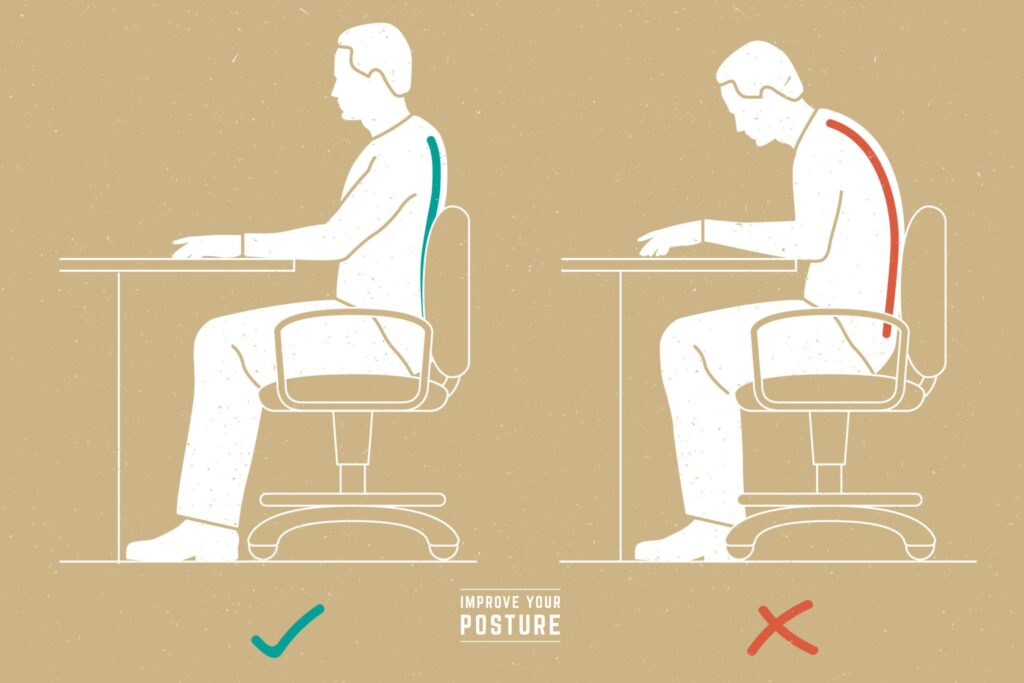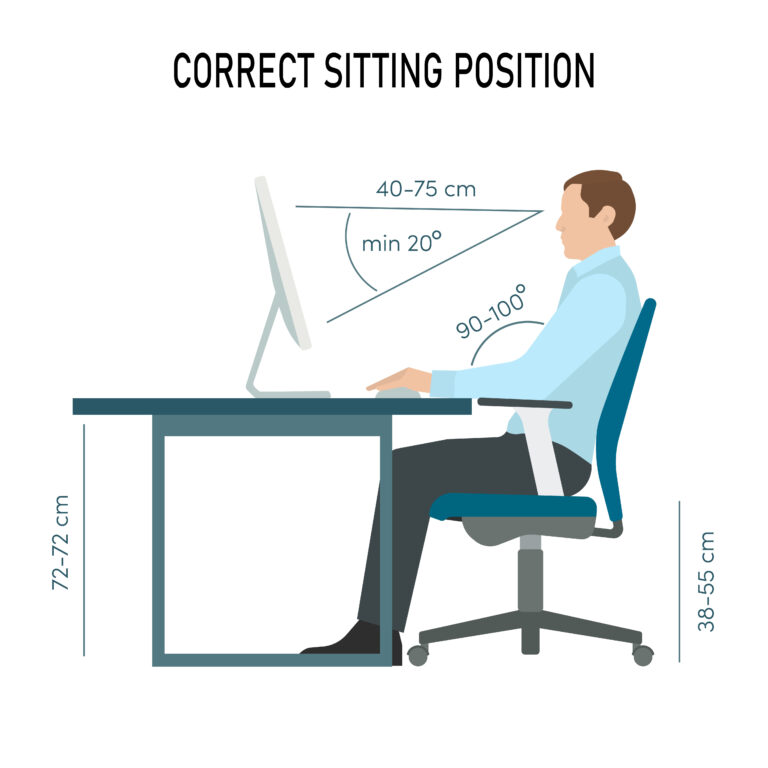
In today’s digital age, office workers spend long hours in front of computers, which can lead to poor posture and various health issues. In addition to being uncomfortable, poor posture can have long-term effects like migraines, neck strain, and back pain. Fortunately, improving your office posture is not only possible but essential for your overall well-being. In this blog, we’ll provide effective office posture tips that can help you fix your posture, along with advice on choosing the right office chair posture.
Key Takeaways
- Proper Office Posture: Maintaining a good posture is essential for preventing pain and improving productivity. The right office posture can help reduce strain on your back, neck, and shoulders.
- Office Chair Adjustments: Ensuring your office chair is properly adjusted for lumbar support, seat height, and armrest position is crucial for maintaining a comfortable and healthy posture.
- Monitor and Desk Setup: Position your monitor at eye level and your keyboard and mouse at a comfortable height to prevent neck and wrist strain.
- Strengthening Core Muscles: A strong core supports better posture by engaging the muscles necessary for spine stability.
- Mindfulness and Regular Breaks: Being mindful of your posture throughout the day and taking frequent breaks helps prevent long-term discomfort and stress on your body.
Table of Contents
Why Office Posture Matters
Good posture is vital for preventing discomfort and health problems. The way you sit and stand affects your spine’s alignment, muscle tension, and even your productivity. Bad posture can lead to:
- Back and neck pain: Poor posture strains the muscles and joints in your spine, causing discomfort and stiffness.
- Reduced energy: Slouching can make you feel tired and drained due to inefficient muscle use.
- Increased stress: Poor alignment can cause tension and discomfort, leading to more stress during the day.
- Lower productivity: Being uncomfortable or in pain can reduce your focus and energy, affecting your overall work performance.
By adopting proper office posture, you can prevent these issues and enjoy a more comfortable, productive workday.
Posture Correction Tips for Office Workers

Improving your posture at work doesn’t require drastic changes, but instead small adjustments that make a big difference. Below are some practical office posture tips that you can easily implement.
- Adjust Your Office Chair for Proper Posture
One of the most crucial factors in office chair posture is ensuring your chair is set up correctly. A comfortable and well-adjusted chair can significantly improve your posture.
Lumbar Support: Choose a chair with proper lumbar support that aligns with the natural curve of your spine. This helps prevent lower back pain and encourages a neutral spine position.
- Monitor Height and Distance
The way you position your monitor can also impact your posture. Here are some tips to set up your monitor correctly:
Eye Level: Position the top of your monitor screen at or slightly below eye level. This ensures you don’t strain your neck by constantly looking up or down.
Avoid Glare: To prevent eye and neck strain, position your screen to reduce glare from windows or overhead lighting.
- Practice Proper Sitting Posture
While sitting, it’s essential to maintain an upright position that supports the natural curvature of your spine.Here’s how to correct your posture when sitting at your desk:
Sit Back in Your Chair: Your back should be fully supported by the backrest of your chair. Avoid leaning forward or slouching.
Avoid Hunching: Keep your shoulders relaxed and avoid rounding your back. Your elbows should be close to your body at a 90-degree angle when typing.
Take Frequent Breaks: Sitting in the same position for long periods can strain your muscles and joints. Every 30 minutes, take a walk, stretch, or get up to release tension.
- Strengthen Core and Postural Muscles
Strengthening your abdominal, back, and pelvic muscles can help you maintain better posture naturally. Try these exercises:
Planks: Hold a plank position for one minute to strengthen your core.
Wall Sits: To strengthen your legs and core, hold a squat position against a wall for 30 seconds.
A strong core supports good posture and reduces the strain on your spine throughout the day.
- Posture-Friendly Desk Setup
An ergonomically designed desk can make a huge difference in supporting good posture. Make sure your desk setup is conducive to a healthy posture:
Desk Height: Your desk should be at a height where your elbows are at a 90-degree angle when typing, and your wrists should be in a neutral position to avoid strain.
- Use a Footrest if Necessary
A footrest might help you maintain a pleasant and healthy posture if your chair is too high. By supporting your feet and maintaining a straight knee angle, a footrest helps you avoid putting undue strain on your legs and lower back.
- Mind Your Posture When Standing
Good posture is just as important when standing. If you stand for extended periods, ensure that your weight is evenly distributed between both feet. Avoid locking your knees and stand with your shoulders back. When standing for long periods, consider using a footrest or shifting your weight from one foot to the other.
How to Fix Posture: Mindfulness and Awareness
Awareness is the first step to fixing bad posture. Unconscious habits like slouching or leaning forward are the root cause of most posture problems. Set reminders to check your posture every hour. Are your shoulders relaxed? Is your spine upright? Use posture-tracking apps or even mirrors as feedback tools. Over time, this consistent mindfulness rewires your posture habits and encourages long-term improvements without strain.
Posture Awareness Techniques:
- Set Posture Reminders
Use alarms or apps like Upright, Posture Reminder, or even your phone’s timer to prompt posture checks every 30–60 minutes.
2. Use a Mirror
Maintain a tiny mirror close to your workstation or on your desk. Glancing at it periodically helps you catch slouching or forward head posture.
3. Try a Posture Tracker
Wearable devices like Upright GO or smartwatches can detect when you slouch and vibrate to gently remind you to sit up straight.
4. Body Scan Technique
For sixty seconds, mentally go over your entire body from head to toe. Are your shoulders tense? Is your neck leaning forward? Adjust each area mindfully.
5. The Wall Test
Place yourself so that your heels, buttocks, shoulders, and head are all in contact with a wall. Hold the position for a minute. This reinforces what proper posture feels like.
6. Sticky Note Cues
Place sticky notes on your monitor or desk with short cues like “Sit tall!” or “Relax shoulders.” Visual cues help retrain posture habits over time.
Final Thoughts
Good posture is an essential part of maintaining overall health and well-being. By following these office posture tips, adjusting your office chair posture, and practicing proper sitting and standing habits, you can significantly reduce discomfort and increase your productivity.
Remember, fixing your posture is not a one-time change—it’s a lifestyle shift that requires consistency. By incorporating these changes into your daily routine and staying mindful of your posture, you’ll experience a healthier, more comfortable work life.
If you’re dealing with persistent posture-related pain or discomfort, consider consulting with a healthcare professional or ergonomic specialist to ensure your workspace is set up to support your body’s natural alignment.
Start today by taking small steps toward improving your office posture—your back will thank you!
Improve Your Posture with Expert Care
Struggling with back, neck, or joint pain due to poor office posture? Pentagon Multispecialty Hospital’s Orthopedics Department offers comprehensive care for musculoskeletal conditions, including spine and joint issues. Our experienced team provides both non-surgical and surgical treatments to help you regain mobility and comfort.
Explore our services and book an appointment today:
FAQs
Why is office posture important?
Good office posture is essential for preventing musculoskeletal discomfort, reducing strain on the spine, and improving overall productivity. It helps maintain alignment, prevents long-term pain, and enhances comfort.
How do I fix my posture at work?
To fix your posture, start by adjusting your office chair to ensure proper lumbar support, keep your feet flat on the floor, and position your monitor at eye level. Regular breaks and mindfulness are key to maintaining good posture throughout the day.
What are the best exercises to improve office posture?
Exercises like planks, bridges, and wall sits are excellent for strengthening core muscles, which support good posture. Simple stretching exercises for the back and shoulders can also help relieve tension and promote better posture.
How can I prevent neck and back pain from poor office posture?
Ensure your chair supports your back, adjust your workstation to maintain proper ergonomics, and avoid slouching.
Can an ergonomic chair improve my posture?
Yes! An ergonomic chair can make a significant difference in supporting your spine and encouraging better posture.
How often should I take breaks for posture improvement?
Take a break every 30 minutes to stand up, stretch, and walk around for at least 5 minutes. This helps prevent muscle stiffness and promotes better posture throughout the day.
How do I know if my posture is correct?
If you feel any discomfort or strain in your back, neck, or wrists, it may indicate poor posture.
How does improving posture and ergonomics help prevent long-term back problems?
Improving posture and following ergonomic principles can significantly reduce physical strain, enhance comfort, and help prevent chronic musculoskeletal disorders. Proper alignment of the spine, along with supportive furniture and healthy movement habits, lowers the risk of developing long-term back pain and related issues. Learn more about ergonomics and its benefits.
We look forward to assisting you with your healthcare needs.
Just Make an Appointment
and You’re Done!


